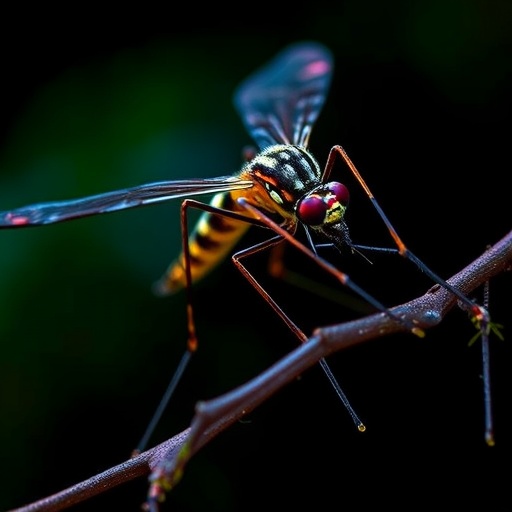In a groundbreaking advance toward malaria control, scientists have demonstrated the ability to efficiently drive a protective genetic variant of the mosquito FREP1 gene through wild-type populations, offering a promising new strategy to suppress the transmission of Plasmodium falciparum. This study meticulously explores the dynamics of allelic drive within freely mating mosquito populations, highlighting the stability and efficacy of a novel gene editing system designed to combat malaria at its vector source.
The researchers utilized a linked allelic-drive element comprised of a vasa-Cas9 transgene paired with a gene cassette encoding the FREP1RFP-gRNA-Q224 allele. This construct was introduced into mosquito cages containing a majority of mosquitoes homozygous for a target allele, FREP1GFP-L224, at an initial 1:3 allelic ratio. Over multiple generations in triplicate experiments, the frequency of mosquitoes carrying the drive-linked allele steadily increased from 50% to approximately 64%, maintaining this proportion through the tenth generation. This observation underscored the system’s robustness in promoting the protective allele without overt fitness disadvantages.
Reciprocally, the population carrying the receiver allele, FREP1GFP-L224, settled at a stable 83% frequency. The persistent coexistence of both alleles across generations reflects the two variants’ comparable fitness under laboratory conditions. Such balanced allelic frequencies are crucial for understanding the evolutionary dynamics that govern gene drive systems and their potential impact in natural populations.
.adsslot_B8AFCiaMPz{width:728px !important;height:90px !important;}
@media(max-width:1199px){ .adsslot_B8AFCiaMPz{width:468px !important;height:60px !important;}
}
@media(max-width:767px){ .adsslot_B8AFCiaMPz{width:320px !important;height:50px !important;}
}
ADVERTISEMENT
Importantly, the study addressed concerns about the generation of non-homologous end joining (NHEJ) alleles, which can often interfere with gene drives by creating resistant mutations. In these experiments, the fraction of NHEJ alleles was low from the start—averaging 5.4% at generation one—and diminished to under 0.5% by generation ten. This declining trend suggests that loss-of-function mutations in FREP1 might carry fitness costs, leading to their gradual elimination. The minimal accumulation of such alleles is critical for ensuring the long-term success and stability of gene drive technologies.
The researchers further examined the performance of the drive in a genetic background with reduced homology—a condition mimicking natural heterogeneity. Specifically, they tested the linked FREP1RFP-gRNA-Q224 drive against wild-type FREP1L224 alleles, which share only a 126-base pair homology region flanking the guide RNA cleavage site, in contrast to the over 1.2 kilobase homology present in congenic lines. This asymmetry posed challenges for gene conversion, leading to a significant number of cleavage events causing damage and lethality in individuals possessing both the drive and Cas9 components.
Despite this fitness cost manifesting as an initial reduction in the frequency of the drive allele within populations, the gene drive element maintained a stable frequency over more than 10 generations. This persistence, even under suboptimal homology conditions, illustrates the system’s resilience and suggests its feasibility for localized allelic drive applications, where spatially restricted genetic changes may be desirable for ecological or ethical reasons.
Beyond genetic metrics, the study critically evaluated the functional outcome of spreading the protective allele in terms of malaria transmission. Mosquitoes harvested from each cage at generation 11 underwent parasite challenge assays using P. falciparum gametocyte concentrations designed to replicate natural low infection intensities. Remarkably, all sampled populations exhibited robust parasite suppression; median oocyst counts dropped from 9 in wildtype cages to zero or near zero in tested cages. These results provide compelling experimental evidence that driving the FREP1Q224 variant into mosquito populations could concretely reduce malaria transmission potential.
The underlying mechanism by which FREP1Q224 confers resistance is thought to involve disruption of the interaction between Anopheles mosquitoes and Plasmodium parasites, interfering with parasite establishment in the mosquito midgut. The allelic drive strategy ensures that this protective variant not only persists but becomes dominant, translating genetic changes into vector competence reduction at a population scale.
Crucially, the system’s design minimizes the unintended generation of deleterious allelic variants that could offset these benefits. The researchers observed a steady decline in NHEJ alleles, cementing the premise that functional gene conversion events predominate over mutagenic repair pathways. This bias enhances the prospects for durable, population-wide replacement of susceptible alleles.
The lethality observed under conditions of partial homology mismatch further elucidates how genomic context influences drive outcomes. While extensive homology facilitates efficient and safe gene conversion, reduced homology can induce target chromosome damage and fitness costs in drive carriers. These findings highlight the importance of chromosome architecture and sequence conservation when designing gene drive interventions and support the development of localized, safer drive systems for field deployment.
Taken together, this study pioneers a path toward applying sophisticated gene editing tools not merely for population suppression but for allele replacement strategies that imbue natural mosquito populations with genetic resistance to malaria parasites. Unlike traditional strategies that rely on eradication or population reduction, allelic drives promise sustainable and adaptive solutions by harnessing evolutionary processes.
The work also advances understanding of how gene drive systems operate at the population genetics level. The observed equilibria, fitness parity between alleles, and minimization of resistant mutation accumulation provide a roadmap for optimizing future genetic control programs. It becomes clear that balancing drive efficiency with ecological mitigation will be key in transitioning these technologies from lab to field.
Ultimately, these findings offer hope for combating malaria transmission through a genetic approach that complements existing vector control measures. The linkage of a protective FREP1 variant to a gene drive element capable of efficient, sustained spread in mosquito populations creates a powerful tool for public health. As malaria continues to impact millions yearly, this research marks a pivotal step towards innovative, genetic-based malaria eradication efforts.
The implications extend beyond malaria as well. This study sets a precedent for functional allelic drives targeting genes of ecological or medical importance in diverse species, opening new frontiers in disease vector management and genetic pest control. As gene editing platforms evolve, refined allelic drives stand to revolutionize how humanity intervenes in vector-borne disease cycles and biodiversity challenges.
Subject of Research: Genetic engineering of mosquitoes to drive protective haplotypes against Plasmodium falciparum infection
Article Title: Driving a protective allele of the mosquito FREP1 gene to combat malaria
Article References:
Li, Z., Dong, Y., You, L. et al. Driving a protective allele of the mosquito FREP1 gene to combat malaria. Nature (2025). https://doi.org/10.1038/s41586-025-09283-6
Image Credits: AI Generated
Tags: allelic drive in mosquitoesengineering mosquito geneticsevolutionary dynamics of allelesFREP1 gene modificationgene editing for disease preventionlaboratory studies on gene frequencymalaria control strategiesmosquito population dynamicsmosquito vector control innovationsPlasmodium falciparum transmissionprotective genetic variants in insectsvasa-Cas9 transgene technology





